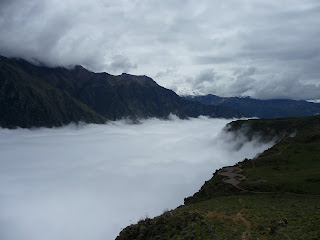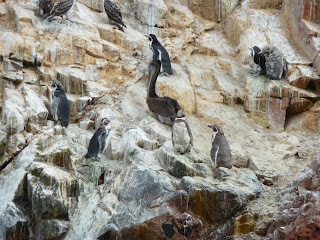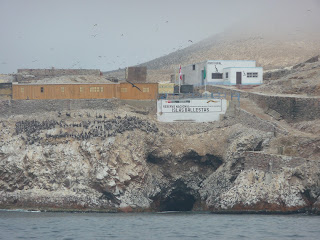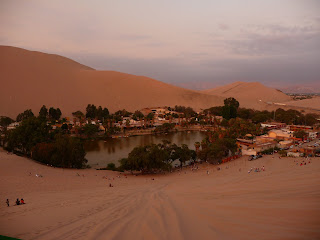Un blog de viaje tiene una ventaja clara: siempre hay un fin. Como ahora ya he vuelto a Europa y estoy a punto de empezar nuevas aventuras, el tiempo para cerrar este diario ha llegado.
En general, todo fue genial: pienso que he visto casi todo lo que era físicamente posible, fui a lugares increíbles, conocí gente increíblemente simpática y además, no me han secuestrado, no me han robado, de verdad nunca me sentía en ningún peligro (bueno, una vez sí, pero eso probablemente fue infundado también).
Para terminar, publicaré unos datos y hechos interesantes sobre mis 44 días:
Viajes
- Lo más largo: Medellín-Cartagena, 13 horas. Más largo que el vuelo transatlántico...
- Lo más caro: Santa Rosa-Iquitos (en barco), 90 USD. También un buen candidato para la conexión más larga con sus 12 horas.
- Lo más cómodo: Cuzco-Puno en un bus super chulo. Si alguien va a hacerlo un día, la empresa Transzela es muy recomendable.
- Lo más incómodo: Santa Rosa-Iquitos. Imagínate un bus con una silla muy pequeña, cero espacio para las piernas y un vehículo cuyo motor para cada 20-30 minutos.
Alojamiento
- Lo mejor: Arequipay Backpacers, Arequipa, Perú, sin duda. Un lugar que merece una recomendación aquí: http://www.arequipaybackpackers.com/ (he checkeado su sitio de web solamente ahora, es tan impresionante como el hostal mismo!)
- Lo peor: Brisas del Amazonas, Santa Rosa, Perú. Falta de electricidad y limpieza, paredes inexistentes, cucarachas, mucho ruido y un calor infernal. Al menos, no costó casi nada.
- Lo más caro: Hospedaje Colibrí, Iquitos, Perú (45 soles, 16,85 USD). No está mal pero de verdad, no vale el precio.
- Lo más barato: Hostal El Solario, La Paz. Con el precio de 25 Bs (3,62 USD) viene también un ambiente bastante duro y la falta de agua caliente. Un candidato muy fuerte para este título era el Hospedaje Las Palmeras en Oasis Sangalle (Cañón de Colca) con sus 10 soles (3,75 USD) y su mucho, mucho mejor servicio de lo que indicaría la diferencia de 13 centimos.
- El personal más amable: Duque Inn, Puno, Perú (http://www.duqueinn.com/ - Ricardo, el dueño es una persona excepcional) y Arequipay Backpackers.
- El personal menos amable: Hostal Mahatu, Leticia, Colombia.
- Alojamiento más duro: Wild Rover Hostel, La Paz, Bolivia (¿que puedes decir si estás despertado a las 4 de la madrugada por una pelea en tu habitación?) y Brisas del Amazonas (bebé en la habitación al lado con padres negligentes, falta de electricidad que es fatal con el clima de Amazonia).
Gente
- Lo más amable: Demasiada, sería imposible enumerar toda.
- Lo menos amable: El dueño del Hostal Mahatu en Leticia que contrata gente indígena para 30% y el turista alemán en Medellín que no habló nada de español ni de inglés pero lo consideró como si fuera normal y el resto del mundo tuviera que hablar alemán.
- Húngaros: Un chico en Iquitos, nada más.
- Países más representados entre los turistas: Chile, sin duda. Encontré también muchos australianos y algunas partes de Perú estaban llenos de franceses.
Gastronomía
- La mejor comida: Ceviche en Iquitos y en Lima. Riqueza increíble.
- La peor comida: Cuy en Arequipa. Cero carne, cero sabor.
- La comida más rara: Otra vez el cuy. Lo intenté solamente para tener la experiencia, pero es super raro comer un animal mascota de verdad.
- La mejor cerveza: Cusqueña, Perú.
- La peor cerveza: Cualquiera en Bolivia.
Muchas gracias por la atención de todas y todos, hasta luego y buen viaje!
 |
| El autor escribiendo sus notas |
A travel blog has the clear advantage of having a beginning and an end. Since by now I have already returned to Europe and I am on the brink of starting some new adventures, time has come to close this diary.
All in all, everything was perfect: I think I have visited almost everything what was physically possible, I've been to incredible places, I got to know incredibly nice people and on the top of that, I have not been kidnapped, robbed and I never ever felt any sense of danger (ok, once I did, but that was probably unfounded as well).
For the last post, I will publish certain interesting facts and figures regarding my 44 days:
Trips
- The longest: Medellín-Cartagena, 13 hours. Longer than the transatlantic flight...
- The most expensive: Santa Rosa-Iquitos (by boat), 90 USD. Also a good candidate for the longest ride with its 12 hours.
- The most comfortable: Cuzco-Puno, in a very nice bus. If someone is looking forward to doing the ride, Transzela is a most recommended company for that connection.
- The most uncomfortable: Santa Rosa-Iquitos. Imagine a bus with a very small seat, no space for your legs and a vehicle the engine of which stops every 20-30 minutes.
Accommodation
- The best: Arequipay Backpacers, Arequipa, Peru, without the slightest doubt. A place which is definitely worth to have a recommendation here: http://www.arequipaybackpackers.com/ (having checked their website, I can say that it is as excellent as the hotel itself!)
- The worst: Brisas del Amazonas, Santa Rosa, Peru. No electricity and cleaning, non-existent walls, cockroaches, a lot of noise and a baking heat. At least it was really cheap.
- The most expensive: Hospedaje Colibrí, Iquitos, Peru (45 soles, 16,85 USD). It wasn't bad but honestly, it did not worth the price.
- The cheapest: Hostal El Solario, La Paz. With the price of 25 Bs (3,62 USD) comes a quite rough environment and the lack of hot water. A very strong candidate for this title was Hospedaje Las Palmeras in Oasis Sangalle (in the Colca Canyon) with its 10 soles (3,75 USD) and with its much, much better service than the 13 cents difference would normally indicate.
- Best staff: Duque Inn, Puno, Peru (http://www.duqueinn.com/ - Ricardo, the owner is a truly excepcional fellow) and Arequipay Backpackers.
- Worst staff: Hostal Mahatu, Leticia, Colombia.
- Roughest accomodation: Wild Rover Hostel, La Paz, Bolivia (what can you say if you're woken up at 4am by a fight in your room?) and Brisas del Amazonas (baby in the room next door with ignorant parents, no electricity which is quite dreadful with the amazonian climate).
People
- The most lovely: Too many, it would be impossible to list all of them.
- The least lovely: The owner of Hostal Mahatu in Leticia who contracts indigenous people for 30% and the German guy in Medellín who did not speak neither Spanish nor English but considered it as normal as if the rest of the world should speak German.
- Hungarians on the road: One guy in Iquitos, full stop.
- Most represented countries amongst the tourists: Chile, without a doubt. I met loads of Australians as well and certain parts of Peru were full of French people.
Gastronomy
- Best meal: Ceviche in Iquitos and in Lima. So incredibly tasty.
- Worst meal: Cuy (guinea pig) in Arequipa. No meat, no taste.
- The weirdest: Once again the cuy. I only tried it for the experience but in all honesty, it's really weird to eat a pet animal.
- Best beer: Cusqueña, Peru.
- Worst beer: Any kind in Bolivia.
Thanks for your attention in the past weeks, see you later and godspeed!
For the last post, I will publish certain interesting facts and figures regarding my 44 days:
Trips
- The longest: Medellín-Cartagena, 13 hours. Longer than the transatlantic flight...
- The most expensive: Santa Rosa-Iquitos (by boat), 90 USD. Also a good candidate for the longest ride with its 12 hours.
- The most comfortable: Cuzco-Puno, in a very nice bus. If someone is looking forward to doing the ride, Transzela is a most recommended company for that connection.
- The most uncomfortable: Santa Rosa-Iquitos. Imagine a bus with a very small seat, no space for your legs and a vehicle the engine of which stops every 20-30 minutes.
Accommodation
- The best: Arequipay Backpacers, Arequipa, Peru, without the slightest doubt. A place which is definitely worth to have a recommendation here: http://www.arequipaybackpackers.com/ (having checked their website, I can say that it is as excellent as the hotel itself!)
- The worst: Brisas del Amazonas, Santa Rosa, Peru. No electricity and cleaning, non-existent walls, cockroaches, a lot of noise and a baking heat. At least it was really cheap.
- The most expensive: Hospedaje Colibrí, Iquitos, Peru (45 soles, 16,85 USD). It wasn't bad but honestly, it did not worth the price.
- The cheapest: Hostal El Solario, La Paz. With the price of 25 Bs (3,62 USD) comes a quite rough environment and the lack of hot water. A very strong candidate for this title was Hospedaje Las Palmeras in Oasis Sangalle (in the Colca Canyon) with its 10 soles (3,75 USD) and with its much, much better service than the 13 cents difference would normally indicate.
- Best staff: Duque Inn, Puno, Peru (http://www.duqueinn.com/ - Ricardo, the owner is a truly excepcional fellow) and Arequipay Backpackers.
- Worst staff: Hostal Mahatu, Leticia, Colombia.
- Roughest accomodation: Wild Rover Hostel, La Paz, Bolivia (what can you say if you're woken up at 4am by a fight in your room?) and Brisas del Amazonas (baby in the room next door with ignorant parents, no electricity which is quite dreadful with the amazonian climate).
People
- The most lovely: Too many, it would be impossible to list all of them.
- The least lovely: The owner of Hostal Mahatu in Leticia who contracts indigenous people for 30% and the German guy in Medellín who did not speak neither Spanish nor English but considered it as normal as if the rest of the world should speak German.
- Hungarians on the road: One guy in Iquitos, full stop.
- Most represented countries amongst the tourists: Chile, without a doubt. I met loads of Australians as well and certain parts of Peru were full of French people.
Gastronomy
- Best meal: Ceviche in Iquitos and in Lima. So incredibly tasty.
- Worst meal: Cuy (guinea pig) in Arequipa. No meat, no taste.
- The weirdest: Once again the cuy. I only tried it for the experience but in all honesty, it's really weird to eat a pet animal.
- Best beer: Cusqueña, Peru.
- Worst beer: Any kind in Bolivia.
Thanks for your attention in the past weeks, see you later and godspeed!






















































